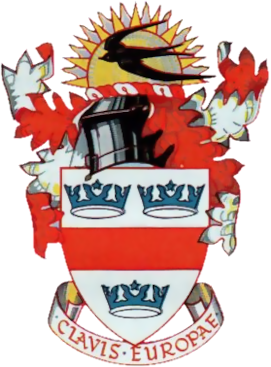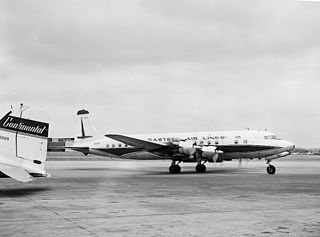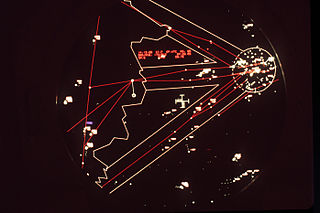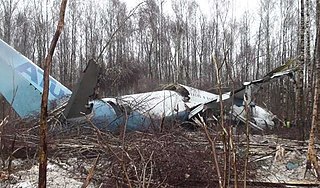
British European Airways (BEA), formally British European Airways Corporation, was a British airline which existed from 1946 until 1974.

The Vickers VC.1 Viking is a British twin-engine short-range airliner derived from the Vickers Wellington bomber and built by Vickers-Armstrongs Limited at Brooklands near Weybridge in Surrey. After the Second World War, the Viking was an important airliner with British airlines, pending the development of turboprop aircraft like the Viscount. An experimental airframe was fitted with Rolls-Royce Nene turbojets and first flown in 1948 as the world's first pure jet transport aircraft. Military developments were the Vickers Valetta and the Vickers Varsity.

In aviation, autoland describes a system that fully automates the landing procedure of an aircraft's flight, with the flight crew supervising the process. Such systems enable airliners to land in weather conditions that would otherwise be dangerous or impossible to operate in.

Eastern Air Lines Flight 512 was a scheduled domestic passenger flight operated by Eastern Air Lines from Charlotte Municipal Airport in Charlotte, North Carolina, to Idlewild Airport in New York City. On November 30, 1962, while attempting to abort an attempted landing at its destination, the Douglas DC-7B operating the flight crashed after it failed to gain altitude and struck the ground. 25 of the 51 occupants of the plane died in the accident. Emergency crews responded, but rescuers were delayed by the thick fog and the soft terrain. An investigation launched after the crash found that the probable cause of the accident was that the pilots had made critical mistakes during the go-around that prevented the aircraft from gaining altitude.

During the Cold War era (1945–1991), the West Berlin air corridors, also known as the Berlin corridors and control zone, were three regulated airways for civil and military air traffic of the Western Allies between West Berlin and West Germany passing over East Germany's territory. The corridors and control zone were physically centered on and under control of the all-Allied Berlin Air Safety Center (BASC) in West Berlin. The airspace within these corridors was used by US, UK and French-registered non-combat aircraft belonging to these countries' armed forces and airlines operated by pilots holding those countries' passports. In addition, it was also used by LOT Polish Airlines for regular scheduled services from Warsaw to London and Paris via Schönefeld Airport to the south of East Berlin.

On March 4, 1966, Canadian Pacific Air Lines Flight 402 (CP402) struck the approach lights and a seawall during a night landing attempt in poor visibility at Haneda Airport in Tokyo, Japan. Of the 62 passengers and 10 crew, only 8 passengers survived.

On 17 February 1959, a Turkish Airlines Vickers Viscount Type 793 on an international charter flight from Esenboğa International Airport in Ankara, Turkey, to London Heathrow Airport diverted to London Gatwick Airport, United Kingdom due to heavy fog. It was carrying the Turkish prime minister and a party of government officials. The Viscount crashed in a wood 3 miles (4.8 km) from the threshold of Gatwick runway during its final approach to land in extensive fog. Five of the eight crew and nine of the 16 passengers died in the crash. The prime minister was among the ten survivors.
Det Danske Luftfartselskab A/S or DDL, trading in English as Danish Air Lines, was Denmark's national airline from 1918 until it merged to create Scandinavian Airlines System (SAS) in 1951. DDL was established on 29 October 1918, but started its first scheduled route on 7 August 1920.

British European Airways Flight S200P was a short-haul flight from London-Northolt Airport to Glasgow-Renfrew Airport, Scotland. On 21 April 1948, while on approach to Renfrew, a Vickers VC.1 Viking, registration G-AIVE, crashed into Irish Law Mountain in North Ayrshire, Scotland. No one died in the accident, but 13 of the 20 passengers and crew were injured, and the aircraft was damaged beyond repair.

Taban Air Flight 6437 was a scheduled domestic flight that crashed on landing at Mashhad, Iran on 24 January 2010. All 170 people escaped from the burning aircraft without loss of life. Most of the passengers were pilgrims returning from visiting holy sites in Iraq.

Ariana Afghan Airlines Flight 701 was the flight involved in a fatal air accident on 5 January 1969, when a Boeing 727 with 62 people on board crashed into a house on its approach to London Gatwick Airport in heavy fog. Due to pilot error the flaps were not extended to maintain flight at final approach speed.

Aviastar-TU Flight 1906 was a Tupolev Tu-204 that crashed while attempting to land at Domodedovo International Airport, Moscow, Russia, in heavy fog on 22 March 2010. The aircraft was on a ferry flight from Hurghada International Airport, Egypt to Moscow, and had no passengers on board; all eight crew survived the accident, four with serious injuries requiring hospitalization and four with minor injuries. The accident was the first hull loss of a Tu-204 and the first hull loss for Aviastar-TU.

The 1957 Nutts Corner BEA Viscount crash was a British European Airways (BEA) flight from London to Belfast that crashed at Nutts Corner Airport on 23 October 1957, killing all seven passengers and crew.

The 1965 Skyways Coach-Air Avro 748 crash occurred on 11 July 1965 when Avro 748-101 Series 1 G-ARMV, flown during a scheduled international passenger flight from Beauvais Airport, Oise, France, crashed on landing at its intended destination of Lympne Airport, Kent, United Kingdom. The accident was due to the grass runway being unable to support the weight of the aircraft during a heavy landing. This caused the nose wheels to dig in and the aircraft to overturn, losing both wings and the starboard tailplane in the process. All 52 people on board survived. This was the first accident involving the Avro 748/HS 748 that resulted in a write-off. A concrete runway was later installed at Lympne.

On 5 January 1953, a Vickers Viking airliner operated by British European Airways crashed on approach to Belfast Nutts Corner Airport, Northern Ireland. The aircraft was on a domestic flight from London Northolt Airport with 31 passengers and 4 crew on board. Twenty-four of the passengers and three crew members died in the accident.

British European Airways Flight 530, also known as the Mistberget Accident, was a controlled flight into terrain of a Douglas C-47 Skytrain into the Mistberget mountain in Eidsvoll, Norway, on 7 August 1946 at ca. 14:00. The British European Airways (BEA) aircraft was en route on a scheduled flight from London's Croydon Airport and crashed during approach to Oslo Airport, Gardermoen.

The 1956 London Heathrow Avro Vulcan crash was a military aviation accident that occurred at Heathrow Airport on 1 October 1956 when Avro Vulcan B.1 XA897 crashed while attempting to land in poor weather. The captain and co-pilot ejected safely but the remaining three crew and one passenger were killed.

British Overseas Airways Corporation (BOAC) was the British state-owned airline created in 1939 by the merger of Imperial Airways and British Airways Ltd. It continued operating overseas services throughout World War II. After the passing of the Civil Aviation Act 1946, European and South American services passed to two further state-owned airlines, British European Airways (BEA) and British South American Airways (BSAA). BOAC absorbed BSAA in 1949, but BEA continued to operate British domestic and European routes for the next quarter century. The Civil Aviation Act 1971 merged BOAC and BEA, effective 31 March 1974, forming today's British Airways.

















